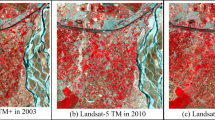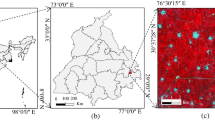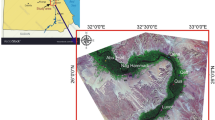Abstract
Remote sensing is one of the most important methods for analysing the multitemporal changes over a certain period. As a cost-effective way, remote sensing allows the long-term analysis of agricultural land by collecting satellite imagery from different satellite missions. Landsat is one of the longest-running world missions which offers a moderate-resolution earth observation dataset. Land surface mapping and monitoring are generally performed by incorporating classification and change detection models. In this work, a deep learning-based change detection (DCD) algorithm has been proposed to detect long-term agricultural changes using the Landsat series datasets (i.e., Landsat-7, Landsat-8, and Landsat-9) during the period 2012 to 2023. The proposed algorithm extracts the features from satellite data according to their spectral and geographic characteristics and identifies seasonal variability. The DCD integrates the deep learning-based (Environment for visualizing images) ENVI Net-5 classification model and posterior probability-based post-classification comparison-based change detection model (PCD). The DCD is capable of providing seasonal variations accurately with distinct Landsat series dataset and promises to use higher resolution dataset with accurate results. The experimental result concludes that vegetation has decreased from 2012 to 2023, while build-up land has increased up to 88.22% (2012–2023) for Landsat-7 and Landsat-8 datasets. On the other side, degraded area includes water (3.20–0.05%) and fallow land (1–0.59%). This study allows the identification of crop growth, crop yield prediction, precision farming, and crop mapping.











Similar content being viewed by others
Dataset availability
The Landsat series dataset can be downloaded from the online web portal (https://earthexplorer.usgs.gov/).
References
Al-Dousari, A. E., Mishra, A., & Singh, S. (2023). Land use land cover change detection and urban sprawl prediction for Kuwait metropolitan region, using multi-layer perceptron neural networks (MLPNN). The Egyptian Journal of Remote Sensing and Space Science, 26(2), 381–392.
Alshari, E. A., Abdulkareem, M. B., & Gawali, B. W. (2023). Classification of land use/land cover using artificial intelligence (ANN-RF). Frontiers in Artificial Intelligence, 5, 964279.
Bali, N., & Singla, A. (2021). Deep learning based wheat crop yield prediction model in Punjab Region of North India. Applied Artificial Intelligence, 35, 1–25. https://doi.org/10.1080/08839514.2021.1976091
Basheer, S., Wang, X., Farooque, A. A., Nawaz, R. A., Liu, K., Adekanmbi, T., & Liu, S. (2022). Comparison of land use land cover classifiers using different satellite imagery and machine learning techniques. Remote Sensing, 14(19), 4978.
Boonpook, W., Tan, Y., Nardkulpat, A., Torsri, K., Torteeka, P., Kamsing, P., Sawangwit, U., Pena, J., & Jainaen, M. (2023). Deep learning semantic segmentation for land use and land cover types using Landsat 8 imagery. ISPRS International Journal of Geo-Information, 12(1), 14.
Chen, H., Wu, C., Du, B., Zhang, L., & Wang, L. (2019). Change detection in multisource VHR images via deep siamese convolutional multiple-layers recurrent neural network. IEEE Transactions on Geoscience and Remote Sensing, 58(4), 2848–2864.
Colligan, T., Ketchum, D., Brinkerhoff, D., & Maneta, M. (2022). A deep learning approach to mapping irrigation using Landsat: IrrMapper U-Net. IEEE Transactions on Geoscience and Remote Sensing, 60, 1–11. https://doi.org/10.1109/TGRS.2022.3175635
Dahiya, N., Gupta, S., & Singh, S. (2022). A review paper on machine learning applications, advantages, and techniques. ECS Transactions, 107(1), 6137–6150. https://doi.org/10.1149/10701.6137ecst
Dahiya, N., Singh, S., & Gupta, S. (2023). A review on deep learning classifier for hyperspectral imaging. International Journal of Image and Graphics, 23(04), 2350036.
Dibs, H., Ali, A. H., Al-Ansari, N., & Abed, S. A. (2023). Fusion Landsat-8 thermal TIRS and OLI datasets for superior monitoring and change detection using remote sensing. Emerging Science Journal, 7(2), 428–444.
Du, P., Wang, X., Chen, D., Liu, S., Lin, C., & Meng, Y. (2020). An improved change detection approach using tri-temporal logic-verified change vector analysis. ISPRS Journal of Photogrammetry and Remote Sensing, 161(December 2019), 278–293. https://doi.org/10.1016/j.isprsjprs.2020.01.026
e Silva, L. P., Xavier, A. P. C., da Silva, R. M., & Santos, C. A. G. (2020). Modeling land cover change based on an artificial neural network for a semiarid river basin in northeastern Brazil. Global Ecology and Conservation, 21, e00811.
Esmaeili, M., Abbasi-Moghadam, D., Sharifi, A., Tariq, A., & Li, Q. (2023). Hyperspectral image band selection based on CNN embedded GA (CNNeGA). IEEE Journal of Selected Topics in Applied Earth Observations and Remote Sensing, 16, 1927–1950. https://doi.org/10.1109/JSTARS.2023.3242310
Eugene, G. Y., Di, L., Meyer, D. J., Zhao, P., Lin, L., Zhang, C., & Cvejovic, S. (2022). ICroplandNet: An open distributed training dataset for irrigated cropland detection. In 2022 10th International Conference on Agro-Geoinformatics (Agro-Geoinformatics) (pp. 1–6).
Farmonov, N., Amankulova, K., Szatmari, J., Sharifi, A., Abbasi-Moghadam, D., Mirhoseini Nejad, S. M., & Mucsi, L. (2023). Crop type classification by DESIS hyperspectral imagery and machine learning algorithms. IEEE Journal of Selected Topics in Applied Earth Observations and Remote Sensing, 1–17. https://doi.org/10.1109/JSTARS.2023.3239756
Felegari, S., Sharifi, A., Khosravi, M., & Sabanov, S. (2023). Using experimental models and multitemporal Landsat-9 images for cadmium concentration mapping. IEEE Geoscience and Remote Sensing Letters, 20, 1–4. https://doi.org/10.1109/LGRS.2023.3291019
Goswami, A., Sharma, D., Mathuku, H., Gangadharan, S. M. P., Yadav, C. S., Sahu, S. K., Pradhan, M. K., Singh, J., & Imran, H. (2022). Change detection in remote sensing image data comparing algebraic and machine learning methods. Electronics (Switzerland), 11(3), 1–26. https://doi.org/10.3390/electronics11030431
Gusain, H. S., Negi, H. S., Dhamija, S., Mishra, V. D., & Snehmani. (2019). Development of avalanche information system using remote sensing and GIS technology in the Indian Karakoram Himalaya. Current Science, 117(1), 104.
He, Y., Yao, S., Yang, W., Yan, H., Zhang, L., Wen, Z., Zhang, Y., & Liu, T. (2021). An extraction method for glacial lakes based on Landsat-8 imagery using an improved U-Net network. IEEE Journal of Selected Topics in Applied Earth Observations and Remote Sensing, 14, 6544–6558. https://doi.org/10.1109/JSTARS.2021.3085397
Henry, C. J., Storie, C. D., Palaniappan, M., Alhassan, V., Swamy, M., Aleshinloye, D., Curtis, A., & Kim, D. (2019). Automated LULC map production using deep neural networks. International Journal of Remote Sensing, 40(11), 4416–4440.
Ienco, D., Gaetano, R., Dupaquier, C., & Maurel, P. (2017). Land cover classification via multitemporal spatial data by deep recurrent neural networks. IEEE Geoscience and Remote Sensing Letters, 14(10), 1685–1689. https://doi.org/10.1109/lgrs.2017.2728698
Jalayer, S., Sharifi, A., Abbasi-Moghadam, D., Tariq, A., & Qin, S. (2023). Assessment of spatiotemporal characteristic of droughts using in situ and remote sensing-based drought indices. IEEE Journal of Selected Topics in Applied Earth Observations and Remote Sensing, 16, 1483–1502. https://doi.org/10.1109/JSTARS.2023.3237380
Jozdani, S. E., Johnson, B. A., & Chen, D. (2019). Comparing deep neural networks, ensemble classifiers, and support vector machine algorithms for object-based urban land use/land cover classification. Remote Sensing, 11(14), 1–24. https://doi.org/10.3390/rs11141713
Kaur, R., Tiwari, R. K., Maini, R., & Singh, S. (2023). A framework for crop yield estimation and change detection using image fusion of microwave and optical satellite dataset. Quaternary, 6(2). https://doi.org/10.3390/quat6020028
Kaur, S., Gupta, S., Singh, S., & Gupta, I. (2022). Detection of Alzheimer’s disease using deep convolutional neural network. International Journal of Image and Graphics, 22(03), 2140012.
Kumar, S., Arya, S., & Jain, K. (2022). A SWIR-based vegetation index for change detection in land cover using multi-temporal Landsat satellite dataset. International Journal of Information Technology, 1–14. https://doi.org/10.1007/s41870-021-00797-6
Kumar, S., & Jain, K. (2020). A multi-temporal Landsat data analysis for land-use/land-cover change in Haridwar Region using remote sensing techniques. Procedia Computer Science, 171, 1184–1193. https://doi.org/10.1016/j.procs.2020.04.127
Liang, Y., Zhang, W., Wang, B., Zheng, Z., Xu, J., Wang, H., & Xu, X. (2022). A more effective way of target segmentation of multispectral imaging data using Kmeans algorithm. In 2022 7th Asia-Pacific Conference on Intelligent Robot Systems (ACIRS) (pp. 82–88).
Lu, D., Li, G., & Moran, E. (2014). Current situation and needs of change detection techniques. International Journal of Image and Data Fusion, 5(1), 13–38. https://doi.org/10.1080/19479832.2013.868372
Lu, D., Mausel, P., Brondízio, E., & Moran, E. (2004). Change detection techniques. International Journal of Remote Sensing, 25(12), 2365–2401. https://doi.org/10.1080/0143116031000139863
Mahmoud, R., Hassanin, M., Al Feel, H., & Badry, R. M. (2023). Machine learning-based land use and land cover mapping using multi-spectral satellite imagery: A case study in Egypt. Sustainability, 15(12), 9467.
Marzvan, S., Moravej, K., Felegari, S., Sharifi, A., & Askari, M. S. (2021). Risk assessment of alien Azolla filiculoides Lam in Anzali Lagoon using remote sensing imagery. Journal of the Indian Society of Remote Sensing, 49(8), 1801–1809. https://doi.org/10.1007/s12524-021-01362-1
Mishra, V. D., Sharma, J. K., & Khanna, R. (2010). Review of topographic analysis methods for the western Himalaya using AWiFS and MODIS satellite imagery. Annals of Glaciology, 51(54), 153–160. https://doi.org/10.3189/172756410791386526
Mohammadi, M., & Sharifi, A. (2021). Evaluation of convolutional neural networks for urban mapping using satellite images. Journal of the Indian Society of Remote Sensing, 49. https://doi.org/10.1007/s12524-021-01382-x
Mohammadi, M., Sharifi, A., Hosseingholizadeh, M., & Tariq, A. (2021). Detection of oil pollution using SAR and optical remote sensing imagery: A case study of the Persian Gulf. Journal of the Indian Society of Remote Sensing, 49. https://doi.org/10.1007/s12524-021-01399-2
Moradi, E., & Sharifi, A. (2023). Assessment of forest cover changes using multi-temporal Landsat observation. Environment, Development and Sustainability, 25(2), 1351–1360. https://doi.org/10.1007/s10668-021-02097-2
Mountrakis, G., & Heydari, S. S. (2023). Harvesting the Landsat archive for land cover land use classification using deep neural networks: Comparison with traditional classifiers and multi-sensor benefits. ISPRS Journal of Photogrammetry and Remote Sensing, 200, 106–119.
Nejad, S. M. M., Abbasi-Moghadam, D., Sharifi, A., Farmonov, N., Amankulova, K., & Laszlz, M. (2023). Multispectral crop yield prediction using 3D-convolutional neural networks and attention convolutional LSTM approaches. IEEE Journal of Selected Topics in Applied Earth Observations and Remote Sensing, 16, 254–266. https://doi.org/10.1109/JSTARS.2022.3223423
Panahi, M., Khosravi, K., Golkarian, A., Roostaei, M., Barzegar, R., Omidvar, E., Rezaie, F., Saco, P. M., Sharifi, A., Jun, C., & Bateni, S. M. (2022). A country-wide assessment of Iran’s land subsidence susceptibility using satellite-based InSAR and machine learning. Geocarto International, 37(26), 14065–14087. https://doi.org/10.1080/10106049.2022.2086631
Panahi, M., Yariyan, P., Rezaie, F., Kim, S. W., Sharifi, A., Alesheikh, A. A., Lee, J., Lee, J., Kim, S., Yoo, J., & Lee, S. (2022). Spatial modeling of radon potential mapping using deep learning algorithms. Geocarto International, 37(25), 9560–9582. https://doi.org/10.1080/10106049.2021.2022011
Pande, C. B. (2022). Land use/land cover and change detection mapping in Rahuri watershed area (MS), India using the google earth engine and machine learning approach. Geocarto International, 37(26), 13860–13880.
Rasheed, M. U., & Mahmood, S. A. (2023). A framework based on deep neural network (DNN) for land use land cover (LULC) and rice crop classification without using survey data. Climate Dynamics, 61(11), 5629–5652. https://doi.org/10.1007/s00382-023-06874-9
Shao, Y., & Lunetta, R. S. (2012). Comparison of support vector machine, neural network, and CART algorithms for the land-cover classification using limited training data points. ISPRS Journal of Photogrammetry and Remote Sensing, 70, 78–87.
Sharifi, A. (2020). Flood mapping using relevance vector machine and SAR data: A case study from Aqqala, Iran. Journal of the Indian Society of Remote Sensing, 48. https://doi.org/10.1007/s12524-020-01155-y
Sharifi, A., & Felegari, S. (2022). Nitrogen dioxide (NO2) pollution monitoring with sentinel-5P satellite imagery over during the coronavirus pandemic (case study: Tehran). Remote Sensing Letters, 13(10), 1029–1039. https://doi.org/10.1080/2150704X.2022.2120780
Singh, A. (1989). Review article digital change detection techniques using remotely-sensed data. International Journal of Remote Sensing, 10(6), 989–1003.
Singh, G., Sethi, G. K., & Singh, S. (2021a). Performance analysis of deep learning classification for agriculture applications using Sentinel-2 data (Vol. 1). Springer. https://doi.org/10.1007/978-981-16-3660-8_19
Singh, G., Sethi, G. K., & Singh, S. (2021b). Survey on machine learning and deep learning techniques for agriculture Land. SN Computer Science, 2(6), 487. https://doi.org/10.1007/s42979-021-00929-6
Singh, R. K., Singh, P., Drews, M., Kumar, P., Singh, H., Gupta, A. K., Govil, H., Kaur, A., & Kumar, M. (2021c). A machine learning-based classification of LANDSAT images to map land use and land cover of India. Remote Sensing Applications: Society and Environment, 24, 100624. https://doi.org/10.1016/j.rsase.2021.100624
Singh, S., Tiwari, R. K., Sood, V., & Gusain, H. S. (2021d). Detection and validation of spatiotemporal snow cover variability in the Himalayas using Ku-band (13.5 GHz) SCATSAT-1 data. International Journal of Remote Sensing, 42(3), 805–815. https://doi.org/10.1080/2150704X.2020.1825866
Singh, G., Singh, S., Sethi, G. K., & Sood, V. (2022a). Detection and mapping of agriculture seasonal variations with deep learning–based change detection using Sentinel-2 data. Arabian Journal of Geosciences, 15(9), 1–19. https://doi.org/10.1007/s12517-022-10105-6
Singh, G., Singh, S., Sethi, G., & Sood, V. (2022b). Deep learning in the mapping of agricultural land use using sentinel-2 satellite data. Geographies, 2(4), 691–700. https://doi.org/10.3390/geographies2040042
Singh, S., Tiwari, R. K., Sood, V., Gusain, H. S., & Prashar, S. (2022c). Image fusion of Ku-Band-based SCATSAT-1 and MODIS data for Cloud-Free change detection over Western Himalayas. IEEE Transactions on Geoscience and Remote Sensing, 60. https://doi.org/10.1109/TGRS.2021.3123392
Sood, V., Gusain, H. S., Gupta, S., Singh, S., & Kaur, S. (2020). Evaluation of SCATSAT-1 data for snow cover area mapping over a part of Western Himalayas. Advances in Space Research, 66(11), 2556–2567. https://doi.org/10.1016/j.asr.2020.08.017
Taloor, A. K., Kumar, V., Singh, V. K., Singh, A. K., Kale, R. V., Sharma, R., Khajuria, V., Raina, G., Kouser, B., & Chowdhary, N. H. (2020). Land use land cover dynamics using remote sensing and GIS Techniques in Western Doon Valley, Uttarakhand, India. Geoecology of landscape dynamics (pp. 37–51). https://doi.org/10.1007/978-981-15-2097-6_23
Tariq, A., Yan, J., Ghaffar, B., Qin, S., Mousa, B. G., Sharifi, A., Huq, M. E., & Aslam, M. (2022). Flash flood susceptibility assessment and zonation by integrating analytic hierarchy process and frequency ratio model with diverse spatial data. Water (Switzerland), 14(19). https://doi.org/10.3390/w14193069
Teluguntla, P., Thenkabail, P. S., Oliphant, A., Xiong, J., Gumma, M. K., Congalton, R. G., Yadav, K., & Huete, A. (2018). A 30-m landsat-derived cropland extent product of Australia and China using random forest machine learning algorithm on Google Earth Engine cloud computing platform. ISPRS Journal of Photogrammetry and Remote Sensing, 144, 325–340.
Twisa, S., & Buchroithner, M. F. (2019). Land-use and land-cover (LULC) change detection in Wami River Basin, Tanzania. Land, 8(9), 136.
Yao, J., Mitran, T., Kong, X., Lal, R., Chu, Q., & Shaukat, M. (2020). Landuse and land cover identification and disaggregating socio-economic data with convolutional neural network. Geocarto International, 35(10), 1109–1123.
Zamani, A., Sharifi, A., Felegari, S., Tariq, A., & Zhao, N. (2022). Agro climatic zoning of saffron culture in Miyaneh City by using WLC method and remote sensing data. Agriculture (Switzerland), 12(1), 1–15. https://doi.org/10.3390/agriculture12010118
Zerrouki, N., Harrou, F., Sun, Y., & Hocini, L. (2019). A machine learning-based approach for land cover change detection using remote sensing and radiometric measurements. IEEE Sensors Journal, 19(14), 5843–5850.
Zhang, C., Sargent, I., Pan, X., Li, H., Gardiner, A., Hare, J., Atkinson, P. M., Centre, L. E., & La, L. (2019). Remote Sensing of Environment Joint Deep Learning for land cover and land use classification. Remote Sensing of Environment, 221(November 2018), 173–187. https://doi.org/10.1016/j.rse.2018.11.014
Zhang, K., Yuan, D., Yang, H., Zhao, J., & Li, N. (2023). Synergy of Sentinel-1 and Sentinel-2 imagery for crop classification based on DC-CNN. Remote Sensing, 15(11). https://doi.org/10.3390/rs15112727
Zhang, L., Zhang, L., & Du, B. (2016). Deep learning for remote sensing data: A technical tutorial on the state of the art. IEEE Geoscience and Remote Sensing Magazine, 4(2), 22–40. https://doi.org/10.1109/MGRS.2016.2540798
Zhang, Y., Wang, L., Zhou, Q., Tang, F., Zhang, B., Huang, N., & Nath, B. (2022). Continuous Change Detection and Classification—Spectral Trajectory Breakpoint Recognition for Forest Monitoring. Land, 11(4), 504.
Acknowledgements
The authors would like to thank the United States Geological Survey (USGS), and the National Aeronautics and Space Administration (NASA) for providing Landsat series datasets.
Funding
This research work is financially supported by Women Scientist Scheme-A (WOS-A) Project (Grant no. SR/WOS-A/ET-55/2019) by Department of Science and Technology (DST), Govt. of India and Teachers Associateship for Research Excellence (TARE) Project (Grant no. TAR/2019/000354) by the Science and Engineering Research Board (SERB), Govt. of India.
Author information
Authors and Affiliations
Contributions
Gurwinder Singh, as the first author, had responsibility for conducting the research, including a writing task. Neelam Dahiya and Vishakha Sood performed re-writing tasks and visualization. Sartajvir Singh and; Apoorva Sharma revised the manuscript, respectively. All authors have read and approved the final manuscript.
Corresponding author
Ethics declarations
Ethics approval
All authors have read, understood, and have complied as applicable with the statement on “Ethical responsibilities of Authors” as found in the Instructions for Authors.
Conflict of interest
The authors declare no competing interests.
Additional information
Publisher’s Note
Springer Nature remains neutral with regard to jurisdictional claims in published maps and institutional affiliations.
Rights and permissions
Springer Nature or its licensor (e.g. a society or other partner) holds exclusive rights to this article under a publishing agreement with the author(s) or other rightsholder(s); author self-archiving of the accepted manuscript version of this article is solely governed by the terms of such publishing agreement and applicable law.
About this article
Cite this article
Singh, G., Dahiya, N., Sood, V. et al. ENVINet5 deep learning change detection framework for the estimation of agriculture variations during 2012–2023 with Landsat series data. Environ Monit Assess 196, 233 (2024). https://doi.org/10.1007/s10661-024-12394-8
Received:
Accepted:
Published:
DOI: https://doi.org/10.1007/s10661-024-12394-8




